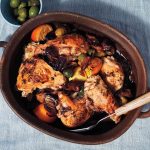In September, during the closing day of the Hebridean Whiskey Festival, rains lashed relentlessly along the southeast coast of the Isle of Skye. The gales were so forceful that they toppled the event tent at the Torabhaig distillery’s courtyard.
Visitors scrambled frantically into the gift shop for shelter, where six distilleries were doling out samples of their single malt scotches, gins, and, in one case, new-make spirit.
While the downpour may have dampened the spirits of some festivalgoers, it was on-brand. Scotland is a nation famous for its rain, but the storms in the Hebrides are particularly punishing.
Charlotte Bronte put it best in her 1847 novel, Jane Eyre:
Where the Northern Ocean, in vast whirls,
Boils round the naked, melancholy isles
Of farthest Thule; and the Atlantic surge
Pours in among the stormy Hebrides.
The festival is a five-day event that highlights the seven distilleries spread across five islands that make up the new Hebridean Whisky Trail. It’s designed to bring awareness to the growing number of distilleries opening on the islands of the Hebrides, an archipelago of more than 40 islands off of Scotland’s northwest coast.
Islay, home to centuries-old distilleries like Bowmore, Lagavulin, and Ardbeg, has long carried the torch for Scotland’s island whiskies. However, the growth of the global whiskey industry has not only spurred production of so-called “new world” whiskey (see: India, Australia, Denmark), it’s also pushed Scotch distillers to the furthest reaches of the nation. This has prompted some to question the longstanding classifications used to organize, and talk about, scotch.
Scotch Whiskey regions
The Scotch Whisky Regulations of 2009 define five legally sanctioned geographical indications: the “protected localities” of Campbeltown and Islay, and the “protected regions” of Highland, Lowland and Speyside.
Highland, the largest in terms of geography, is defined as “north of the line dividing the Highland region from the Lowland.” Its 55 distilleries, which range from modest to massive, stretch along the mainland’s lush hills and river valleys to the ancient slabs of rock in the Atlantic. With such variety of landscapes, which can have a profound effect on spirit-making, to rely on a single classification is a bit of a head-scratcher.
Courtesy of Isle of Harris
Other than location, there’s no categorical differentiation for single malts from one region to another. As long as it’s made in Scotland from water and malted barley, distilled at less than 94.8% alcohol by volume (ABV), aged in oak casks for at least three years, and bottled at no less than 40% ABV, it’s legally scotch.
Defying tradition, distillers like Balvenie are making peaty malts on the mainland, and unpeated expressions are coming out of Bunnahabhain and Bruichladdich on Islay.
So, why bother with regions?
In short: tradition. The longer answer: the history of local commerce.
Scotch was made originally on pot stills to yield a full-bodied spirit. After the continuous still was introduced in the mid-19th century, lighter grain whisky and blended Scotch became a desirable, new style. The industry shifted its focus from producing single malts, or a scotch at one individual distiller, to blends.
To create distinctive identities for single malts during an era when supplies were somewhat unpredictable, blenders sorted them into regional categories. Registers from historic whisky houses from this time show that the groupings were a means to organize records. Centuries later, it was ratified.
“The five traditional localities and regions that we know today were defined in the Scotch Whisky Regulations 2009, not only because they had a very longstanding reputation, with references dating back to 1909, but also because their longstanding reputation made them prone to misuse by bad-faith actors in the global market,” says a spokesman from the Scotch Whisky Association (SWA), the trade body that oversees the industry. “Therefore, whisky distilleries can and do use the name of the region where they are located in the labeling and promotion of their brands without the need for a change in the law.”
Though the SWA spokesman says that “distilleries in different regions are free to promote and build a reputation for their areas,” such generalities are a remnant of days gone by for some.
A case for updating Scotch whisky regions
“In the last 20 years, there’s been an absolute explosion of single malt whisky and special releases fueled by consumers’ desire for new and different stuff,” says Brendan McCarron, a distiller and blender who trained under Dr. Bill Lumsden, head of whisky creation for Glenmorangie and Ardbeg. “That’s caused borders of regions to become quite blurred. I still think regions are relevant, but not as strongly relevant as [they] once were. They’re almost like a tool in your armory to teach people new to whisky.”
Brendan McCarron, Scotch whisky distiller and blender
“Regions bring value to conversation, and an understanding not of where they are and how likely they are to taste, but they teach you about history. Regions are guidance, theories, ideas. They should naturally evolve.”
— Brendan McCarron, Scotch whisky distiller and blender
McCarron consults with distilleries in Japan and England, as well as Benbecula Distillery on Uist, one of the stops on the Hebridean Trail.
“Regions bring value to conversation, and an understanding not of where they are and how likely they are to taste, but they teach you about history,” says McCarron. “Regions are guidance, theories, ideas. They should naturally evolve.”
Education is a priority for Rick Bennett-Baggs, global brand director at Marussia Beverages, which owns Torabhaig on Skye.
“Defining regions has greatly helped scotch over the years,” says Bennett-Baggs. “It helps consumers navigate a complex category, and differentiation creates more intrigue and interest. But single malt scotch is a progressive category. Updating the regions could be something to consider as amazing new brands from different places pop up.
“I don’t think we’d have the conversation 10 or 20 years ago, but many new distilleries have launched in the Hebrides recently,” he says. “And they’re linked to quite a broad definition of the Highland region. The islands being categorized as Highland can be misleading.”
Food and drink regulations outside Scotland
A legal designation for a particular region’s whisky, or any food or drink (see: Parma ham, Camembert and Roquefort cheeses, Darjeeling tea, Champagne) boils down to quality control. It’s designed to protect a region’s integrity and prevent counterfeits. But it’s a relatively new development.
American whiskey was defined by the Pure Food and Drug Act of 1909, but it was the Federal Alcohol Administration Act of 1935 that laid out the rules for bourbon, established as a native spirit of the United States in 1964.
Irish distillers, who were making uisce beatha, (Gaelic for “water of life”) long before the Declaration of Independence was written, didn’t get formal production guidelines until the Irish Whiskey Act of 1980. In 2019, the European Commission approved Irish whiskey’s Geographical Indication.
In April 2021, the Japan Spirits and Liqueurs Makers Association, a non-governmental trade group, implemented labeling standards for its members. The tightened requirements were a response to decades of Japanese producers that blended whiskies from other countries, mainly Canada and Scotland, into their products.
The standards mandated that a bottle of Japanese whisky must contain spirit produced exclusively in the country, and it also laid out regulations on fermentation, aging and bottling. The standards have not been adopted into law by the Japanese government.
The past is a precedent for the ever-expanding industry, for better or worse. In Australia, whisky is defined as a product of fermented grain that’s distilled and aged in wood for at least two years. Such vagueness makes the nascent scene there something of an unregulated frontier, but David Vitale, founder of Starward Australian Whisky, in Melbourne, appreciates the freedom it affords.
Courtesy of Starward Whisky
“The industry uses that broad definition to innovate in ways that wouldn’t be possible if we approached the definition with the rigor that the SWA governs single malt scotch,” says Vitale. “One of the wonderful things in Australia is we can ask, ‘What can we do to distinguish ourselves from the rest of the world?’”
Vitale has made aging in Australian wine casks Starward’s signature. Others toy with nontraditional grains and other types of casks. However, Vitale cautions that there’s risk around growing an industry without a regulatory body to enforce basic standards.
Creative license was a primary consideration for the Empire Rye Association, the collective of distillers that established Empire Rye. The trademarked seal on a bottle of New York-made rye guarantees that the spirit was distilled from a mash bill of at least 75% rye grain grown in state and aged at least two years in new charred oak. Beyond that, there’s room for creativity.
“We’re driven to honor the agricultural heritage of the state and link it to our distilling,” says Allen Katz, cofounder of Brooklyn’s New York Distilling Company and founding member of the association. “There are strong points of view within the community of distillers, so we made sure to be reasonably egalitarian and supportive so as many distilleries that wanted to could ultimately participate. There’s room for experimentation.”
But such flexibility doesn’t sit well with some.
Ryan Norwood is vice president of operations for Sagamore Spirit, a Baltimore distillery that specializes in Maryland rye, a widely recognized style before Prohibition. It was known for being sweeter than other ryes, like Monongahela rye from Pennsylvania. Norwood doesn’t want Maryland rye to become a sanctioned style.
Courtesy of Sagamore Spirit
“I’ve always shied away from it,” says Norwood. “If you put regulations around local rye, it means it could cost more and give you less ability to make what you want to make because you’re bound to a certain way of doing things. In a tough economic environment, that might put some at a disadvantage.”
Norwood says that to sanction this style would also hamper innovation. Sagamore gets its characteristic sweetness from using corn in the mash, but other distillers might use specific barrels or yeast strains to create a similar effect.
There was no shying away from classification among members of the American Single Malt Whisky Commission (ASMWC). Almost a decade of lobbying efforts came to fruition in December, when the Alcohol and Tobacco Tax and Trade Bureau recognized the style as an official category.
“There were roadblocks to presenting our product to retailers and bartenders, let alone [getting] consumers to understand it,” says Steve Hawley, ASMWC president. “We had to establish what the category is and [what it] means. We didn’t want to be lumped into American whiskey. That’s too generic. It wasn’t giving us the due we deserve.”
The future of a Hebridean single malt category
To establish protection for Hebridean single malt is not out of the question, says Simon Erlanger, managing director of the Isle of Harris Distillery. However, it would take time and lots of legal work to get the Scotch Whisky Act changed. But that begs the question: What would define it?
Erlanger says that Harris’s humidity and small seasonal temperature swings are ideal for aging. The water is exceptionally soft, filtered through bedrock that’s billions of years old. But it’s the intangibles that stir him.
“The heart of thinking is economic regeneration of the islands we inhabit,” says Erlanger. “Everyone who works at Harris comes from there. If you took our distilling equipment somewhere else, it’d make different whisky. Putting the region on the map, in some way, could only benefit local communities and tourism. And help us market our whiskies to the world.”







